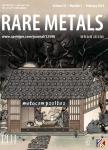Dynamic recrystallization behavior of Fe–20Cr–30Ni–0.6Nb–2Al–Mo alloy
Dynamic recrystallization behavior of Fe–20Cr–30Ni–0.6Nb–2Al–Mo alloy作者机构:School of Materials Science and Engineering Jiangsu University
出 版 物:《Rare Metals》 (稀有金属(英文版))
年 卷 期:2019年第38卷第2期
页 面:181-188页
核心收录:
学科分类:08[工学] 080502[工学-材料学] 0805[工学-材料科学与工程(可授工学、理学学位)]
基 金:financially supported by the National Natural Science Foundation of China (No. 2012AA03A501) the Ordinary University Graduate Student Scientific Research Innovation Projects by Jiangsu Province (No. KYLX-1027)
主 题:Alumina-forming austenitic alloy Constitutivemodel Dynamic recrystallization Critical strain Straininduced grain boundary migration
摘 要:Single-pass compression tests of an aluminaforming austenite(AFA) alloy(Fe–20Cr–30Ni–0.6Nb–2Al–Mo) were performed using a Gleeble-3500 thermal–mechanical simulator. By combining techniques of electron back-scattered diffraction(EBSD) and transmission electron microscopy(TEM), the dynamic recrystallization(DRX) behavior of the alloy at temperatures of 950–1100 ℃ and strain rates of 0.01–1.00 s^(-1) was investigated. The regression method was adopted to determine the thermal deformation activation energy and apparent stress index and to construct a thermal deformation constitutive model. Results reveal that the flow stress is strongly dependent on temperature and strain rate and it increases with temperature decreasing and strain rate increasing. The DRX phenomenon occurs more easily at comparably higher deformation temperatures and lower strain rates. Based on the method for solving the inflection point via cubic polynomial fitting of strain hardening rate(h) versus strain(e) curves, the ratio of critical strain(ec) to peak strain(ep) during DRX was precisely predicted. The nucleation mechanisms of DRX during thermal deformation mainly include the strain-induced grain boundary(GB)migration, grain fragmentation, and subgrain coalescence.



